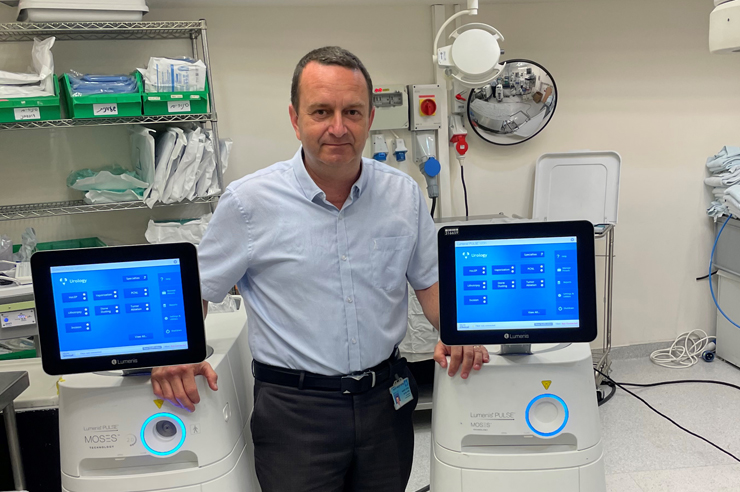
When Technology Meets Urology – State-of-the-Art Kidney Stone & Prostate Treatment
Lumenis, a global leader in medical laser treatments, has taken kidney stone and prostate treatments to the next level with its proprietary Moses™ 2.0 technology, which significantly cuts surgery and hospitalization times and improves patients’ quality of life.
Surgical lasers have had a transformative effect on healthcare, and technologies continue to rapidly evolve, shaping today’s landscape for minimally invasive surgery. One company leading the way is Lumenis, whose cutting-edge Moses™ 2.0 holmium laser technology – developed and patented in Israel – boosts the efficiency and clinical outcomes of two of the most common procedures in any hospital: kidney stone and enlarged prostate treatments.1-3 Patients can expect minimally invasive outpatient procedures, rather than overnight hospital stays, while surgeons and hospitals experience elegant, time-saving procedures with less bleeding and fewer complications.
The world-leading lithotripsy treatment About 1 in 10 people will suffer from kidney stones, with men in their 30s to 50s facing three times the risk of women the same age. Traditionally, methods of removing kidney stones have varied based on the stone’s size and the patient’s condition. “The field of urologic endoscopy is improving – it feels like we’ve soared above the sky", says Professor Mordechai Duvdevani, Deputy Director of Urology and Director of Endo-Urology at Hadassah Ein Kerem Hospital and Secretary General of the Israeli Urological Association . “Up to 30 years ago, treatment was open surgery, which advanced to stone fragmentation by external shock wave treatment, after which endoscopic surgery arrived on the scene. Large stones over 2 cm were removed percutaneously through the patient’s flank area, but new technology allows us to remove larger stones quicker and with a swifter recovery for the patient. Even when percutaneous removal is still required, the incision is much smaller – up to 5 times shorter than previously needed – meaning that patients can go home after only one night at the hospital.”Laser treatment of kidney stones is called lithotripsy (the internal use of energy to break down stones). With Moses 2.0 technology, laser energy is split into two pulses – the first pulse creates a vapor bubble, and the second pulse transmits energy through the bubble, directly to the target. Lithotripsy with Moses 2.0 offers significant clinical benefits, including an up to 85% higher rate of stone fragmentation compared to previous procedures. With targeted Moses 2.0 energy, stone fragments are less likely to scatter during treatment, thereby reducing the risk of fragments moving into distant areas of the kidney and causing complications. Surgeons have much more control, and the procedure is faster and more effective at eliminating stones.
“Laser technology for stones has come a long way in recent decades. Today the holmium laser is standard treatment,” explains Dr. Ehud Gnessin, Senior Physician in Urology at Shamir Assaf-HaRofeh Medical Center and Senior Physician at Assuta in Ramat HaHayal. “Using a 1/5 mm diameter flexible laser fiber with a tiny camera, we can explore the kidney, find the stone and treat it. The first part of the pulse generated by the discharge of the laser dislodges the stone, and Lumenis’ engineers were able to add an additional part within less than a millisecond, preventing the stone from slipping away. In doing so, they streamlined the procedure significantly, and it is now faster and more efficient than ever.”Gold-standard, same-day surgery for enlarged prostate
The prostate, a gland located just below the bladder, grows naturally over time. Eventually, it wraps the urethra and causes urinary disorders. Most men will suffer from this problem naturally at some point in their life, and the incidence increases with age. In fact, prostate enlargement affects 50% of men over age 60 and about 80% of men over age 80. According to Dr. Gnessin, the most common surgical prostate treatment in Israel today is transurethral resection of the prostate (TURP), an endoscopic procedure in which the prostate is treated with an electric knife. TURP surgery can last up to an hour and is limited to the treatment of glands ranging 80cc to 100cc in size. With this treatment, there is a risk of hemorrhage and significant likelihood of a repeat procedure. Moreover, TURP causes erectile dysfunction in 6% of cases. In contrast, the most advanced treatment currently available for enlarged prostate has been holmium laser enucleation of the prostate (HoLEP), an endoscopic procedure where the laser completely removes the part of the prostate that is blocking the urethra. Compared to standard HoLEP, Moses 2.0 cuts treatment time by 20% and significantly reduces the risk of hemorrhaging.2,4 And because HoLEP with Moses 2.0 minimizes bleeding, patients can usually go home the same day without a catheter instead of staying overnight for catheter irrigation. It is also appropriate for many patients using anticaogulants. “HoLEP surgery is more effective because it allows us to remove the prostate tissue, preventing regeneration, even in cases of an extremely enlarged prostates that would otherwise require opening the abdomen. It shortens hospitalization and catherization times, with zero chance of causing erectile disfunction,” explains Dr. Gnessin. “Lumenis has risen to the challenge of increasing the accuracy of the HoLEP procedure. Moses 2.0 improves the laser shockwave and allows for more effective stripping of the tissue, more efficient control of hemorrhaging and a shorter procedure.” Lumenis continues moving forward Lumenis is one of the world’s pioneers in the field of surgical lasers. Its CEO, Tzipi Ozer-Armon, recently chalked up another impressive achievement when Boston Scientific signed a definitive agreement to acquire the company’s surgical division for $1.07 billion in March, announcing that its operations are to remain in Israel and become a laser technology innovation center. “Most of all, we are proud that behind it all stands an Israeli company,” concludes Professor Duvdevani. “We are especially proud of the fact that a company in Israel spearheads global technology, we’re happy that trailblazing technologies in the field of urology originate in Israel.”

